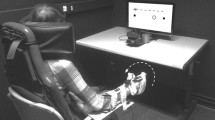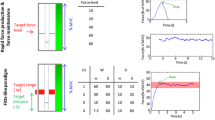Abstract
Though age-related decrease in information-processing capacities is hypothesized to be a prominent cause of behavioral slowing, it has been scarcely systematically studied in goal-directed motor tasks. The present study investigated how the decrease in information processing affects the sensorimotor processes underlying the control of a discrete Fitts’ task. The index of difficulty (ID) of the task was manipulated using changes in either target distance (D) or target width (W). In each manipulation, movement (MTs), acceleration (ATs) and deceleration times (DTs) of young and older participants were compared across eight ID levels. They were analyzed with efficiency functions, state traces and Brinley plots. Our results showed that older participants were always slower. However, in both age groups, MTs were longer in D manipulation, which resulted from a slowing of both ATs and DTs, while W manipulation affected mainly DTs. In D manipulation, equivalent age-related slowing ratios were observed for AT and DT (1.3). In W manipulation, ATs of older participants were additively slower than those of young participants. Conversely, DTs presented a multiplicative slowing ratio of 1.3. These findings showed that ID manipulations differentially loaded information processing in the nervous system and that age-related slowing of multisensory control processes was independent of the manipulated dimension. Nevertheless, ID manipulations revealed different age-related adaptations to task constraints, suggesting that D and W manipulations are complementary means to assess age-related slowing of the processes involved in target-directed rapid-aiming tasks, with D scaling being more specific to capture the slowing of force-impulse control.




Similar content being viewed by others
Notes
Modifications in force-impulse control, reflected in the kinematics and duration of the acceleration phase, should not be confused with the duration of the programing process itself, which can be measured by the reaction time.
References
Bashore TR (1993) Differential effects of aging on the neurocognitive functions subserving speeded mental processing. In: Cerella J, Rybash J, Hoyer W, Commons ML (eds) Adult information processing: limits on loss. Academic Press, New York, pp 37–76
Bashore TR, Ridderinkhof KR, van der Molen MW (1997) The decline of cognitive processing speed in old age. Curr Dir Psychol Sci 6:166–169
Berardelli A, Hallett M, Rothwell JC, Agostino R, Manfredi M, Thompson PD, Marsden CD (1996) Single-joint rapid arm movements in normal subjects and in patients with motor disorders. Brain 119(Pt 2):661–674
Birren JE et al (1980) Behavioral slowing with age: causes, organization, and consequences. In: Poon LW (ed) Aging in the 1980s: psychological issues. American Psychological Association, Washington, DC, pp 293–308
Brinley JF (1965) Cognitive sets, speed and accuracy of performance in the elderly. In: Welford AT, Birren JE (eds) Behavior, aging and the nervous system. Thomas, Springfield, IL, pp 114–149
Cerella J (1985) Information processing rates in the elderly. Psychol Bull 98:67–83
Cerella J (1991) Age effects may be global, not local: comment on Fisk and Rogers (1991). J Exp Psychol Gen 120:215–223
Cerella J (1994) Generalized slowing in Brinley plots. J Gerontol 49:P65–P71
Cerella J, Poon LW, Fozard JL (1982) Age and iconic read-out. J Gerontol 37:197–202
Collins JJ, Luca CJD (1993) Open-loop and closed-loop control of posture: a random-walk analysis of center-of-pressure trajectories. Exp Brain Res 95:308–318
Darling WG, Cooke JD, Brown SH (1989) Control of simple arm movements in elderly humans. Neurobiol Aging 10:149–157
Elliott D, Hansen S, Grierson LEM, Lyons J, Bennett SJ, Hayes SJ (2010) Goal-directed aiming: two components but multiple processes. Psychol Bull 136:1023–1044
Elliott D, Helsen WF, Chua R (2001) A century later: Woodworth’s (1899) two-component model of goal-directed aiming. Psychol Bull 127:342–357
Fitts PM (1954) The information capacity of the human motor system in controlling the amplitude of movement. J Exp Psychol 47:381–391
Fitts PM, Peterson JR (1964) Information capacity of discrete motor responses. J Exp Psychol 67:103–112
Galganski ME, Fuglevand AJ, Enoka RM (1993) Reduced control of motor output in a human hand muscle of elderly subjects during submaximal contractions. J Neurophysiol 69:2108–2115
Goggin NL, Meeuwsen HJ (1992) Age-related differences in the control of spatial aiming movements. Res Q Exerc Sport 63:366–372
Guiard Y, Olafsdottir HB (2011) On the measurement of movement difficulty in the standard approach to Fitts’ law. PLoS ONE 6:e24389
Haaland KY, Harrington DL, Grice JW (1993) Effects of aging on planning and implementing arm movements. Psychol Aging 8:617–632
Hale S, Myerson J, Faust M, Fristoe N (1995) Converging evidence for domain-specific slowing from multiple nonlexical tasks and multiple analytic methods. J Gerontol B Psychol Sci Soc Sci 50:P202–P211
Heath M, Weiler J, Marriott KA, Elliott D, Binsted G (2011) Revisiting Fitts and Peterson (1964): width and amplitude manipulations to the reaching environment elicit dissociable movement times. Can J Exp Psychol 65:259–268
Huys R, Fernandez L, Bootsma RJ, Jirsa VK (2010) Fitts’ law is not continuous in reciprocal aiming. Proc R Soc B 277:1179–1184
Jagacinski RJ, Liao MJ, Fayyad EA (1995) Generalized slowing in sinusoidal tracking by older adults. Psychol Aging 10:8–19
Ketcham CJ, Seidler RD, Gemmert AWAV, Stelmach GE (2002) Age-related kinematic differences as influenced by task difficulty, target size, and movement amplitude. J Gerontol B Psychol Sci Soc Sci 57:P54–P64
Liao MJ, Jagacinski RJ, Greenberg N (1997) Quantifying the performance limitations of older and younger adults in a target acquisition task. J Exp Psychol Hum Percept Perform 23:1644–1664
MacKenzie CL, Marteniuk RG, Dugas C, Liske D, Eickmeier B (1987) Three-dimensional movement trajectories in Fitts’ task: implications for control. Q J Exp Psychol 39A:629–647
MacKenzie IS (1992) Fitts’ law as a research and design tool in human–computer interaction. Hum Comput Interact 7:91–139
Myerson J, Hale S, Wagstaff D, Poon LW, Smith GA (1990) The information-loss model: a mathematical theory of age-related cognitive slowing. Psychol Rev 97:475–487
Pohl PS, Winstein CJ, Fisher BE (1996) The locus of age-related movement slowing: sensory processing in continuous goal-directed aiming. J Gerontol B Psychol Sci Soc Sci 51:P94–P102
Poston B, Gemmert AWAV, Barduson B, Stelmach GE (2009) Movement structure in young and elderly adults during goal-directed movements of the left and right arm. Brain Cogn 69:30–38
Pratt J, Chasteen AL, Abrams RA (1994) Rapid aimed limb movements: age differences and practice effects in component submovements. Psychol Aging 9:325–334
Rey-Robert B, Temprado J-J, Lemaire P, Berton E (2012) Combining movement kinematics, efficiency functions, and Brinley plots to study age-related slowing of sensorimotor processes: insights from Fitts’ task. Gerontology 58:171–180
Salthouse TA, Hancock HE, Meinz EJ, Hambrick DZ (1996) Interrelations of age, visual acuity, and cognitive functioning. J Gerontol B Psychol Sci Soc Sci 51:P317–P330
Seidler-Dobrin RD, Stelmach GE (1998) Persistence in visual feedback control by the elderly. Exp Brain Res 119:467–474
Shannon CE, Weaver W (1949) The mathematical theory of communication. University of Illinois Press, Urbana
Sleimen-Malkoun R, Temprado JJ, Huys R, Jirsa V, Berton E (2012) Is Fitts’ law continuous in discrete aiming? PLoS ONE 7:e41190. doi:10.1371/journal.pone.0041190
Teasdale N, Bard C, Fleury M, Young DE, Proteau L (1993) Determining movement onsets from temporal series. J Mot Behav 25:97–106
Teeken JC, Adam JJ, Paas FG, van Boxtel MP, Houx PJ, Jolles J (1996) Effects of age and gender on discrete and reciprocal aiming movements. Psychol Aging 11:195–198
Van de Crommert HWAA, Mulder T, Duysens J (1998) Neural control of locomotion: sensory control of the central pattern generator and its relation to treadmill training. Gait Posture 7:251–263
Verhaeghen P (2000) The parallels in beauty’s brow: time-accuracy functions and their implications for cognitive aging theories. In: Perfect TJ, Maylor E (eds) Models of cognitive aging. Oxford University Press, Oxford, pp 50–86
Walker N, Philbin DA, Fisk AD (1997) Age-related differences in movement control: adjusting submovement structure to optimize performance. J Gerontol B Psychol Sci Soc Sci 52:P40–P52
Wasylyshyn C, Verhaeghen P, Sliwinski MJ (2011) Aging and task switching: a meta-analysis. Psychol Aging 26:15–20
Welford AT, Norris AH, Shock NW (1969) Speed and accuracy of movement and their changes with age. Acta Psychol (Amst) 30:3–15
Woodworth RS (1899) The accuracy of voluntary movement. Psychol Rev 3(suppl 13):1–119
Yan JH, Thomas JR, Stelmach GE, Thomas KT (2000) Developmental features of rapid aiming arm movements across the lifespan. J Mot Behav 32:121–140
York JL, Biederman I (1990) Effects of age and sex on reciprocal tapping performance. Percept Mot Skills 71:675–684
Acknowledgments
This study was financially supported by a doctoral fellowship awarded by AXA research fund to B. Rey-Robert. The authors thank C. Molines and A. Langar for their contribution to the recruitment and assessment of older participants. We also thank anonymous reviewers for their helpful comments on earlier version of the ms.
Author information
Authors and Affiliations
Corresponding author
Rights and permissions
About this article
Cite this article
Temprado, JJ., Sleimen-Malkoun, R., Lemaire, P. et al. Aging of sensorimotor processes: a systematic study in Fitts’ task. Exp Brain Res 228, 105–116 (2013). https://doi.org/10.1007/s00221-013-3542-0
Received:
Accepted:
Published:
Issue Date:
DOI: https://doi.org/10.1007/s00221-013-3542-0




